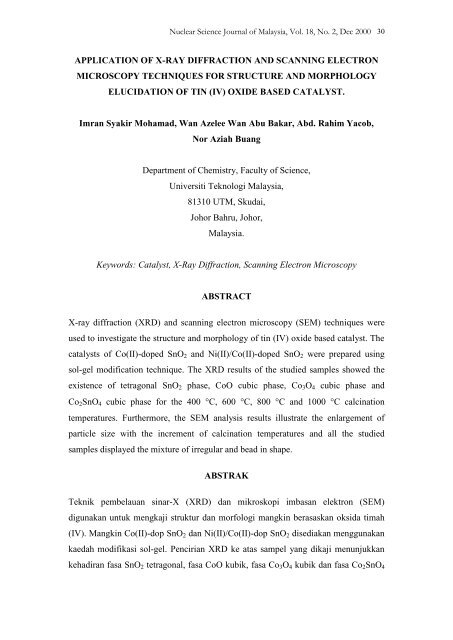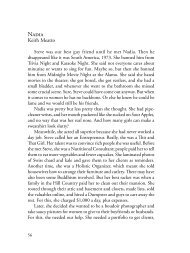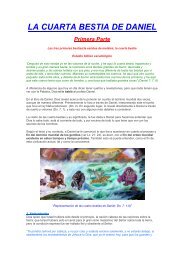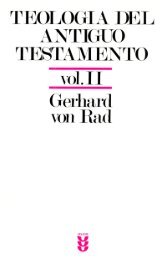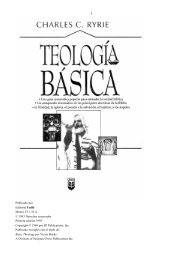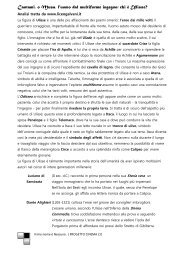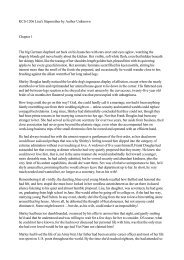application of x-ray diffraction and scanning electron ... - OpenDrive
application of x-ray diffraction and scanning electron ... - OpenDrive
application of x-ray diffraction and scanning electron ... - OpenDrive
Create successful ePaper yourself
Turn your PDF publications into a flip-book with our unique Google optimized e-Paper software.
Nuclear Science Journal <strong>of</strong> Malaysia, Vol. 18, No. 2, Dec 2000 30<br />
APPLICATION OF X-RAY DIFFRACTION AND SCANNING ELECTRON<br />
MICROSCOPY TECHNIQUES FOR STRUCTURE AND MORPHOLOGY<br />
ELUCIDATION OF TIN (IV) OXIDE BASED CATALYST.<br />
Imran Syakir Mohamad, Wan Azelee Wan Abu Bakar, Abd. Rahim Yacob,<br />
Nor Aziah Buang<br />
Department <strong>of</strong> Chemistry, Faculty <strong>of</strong> Science,<br />
Universiti Teknologi Malaysia,<br />
81310 UTM, Skudai,<br />
Johor Bahru, Johor,<br />
Malaysia.<br />
Keywords: Catalyst, X-Ray Diffraction, Scanning Electron Microscopy<br />
ABSTRACT<br />
X-<strong>ray</strong> <strong>diffraction</strong> (XRD) <strong>and</strong> <strong>scanning</strong> <strong>electron</strong> microscopy (SEM) techniques were<br />
used to investigate the structure <strong>and</strong> morphology <strong>of</strong> tin (IV) oxide based catalyst. The<br />
catalysts <strong>of</strong> Co(II)-doped SnO 2 <strong>and</strong> Ni(II)/Co(II)-doped SnO 2 were prepared using<br />
sol-gel modification technique. The XRD results <strong>of</strong> the studied samples showed the<br />
existence <strong>of</strong> tetragonal SnO 2 phase, CoO cubic phase, Co 3 O 4 cubic phase <strong>and</strong><br />
Co 2 SnO 4 cubic phase for the 400 C, 600 C, 800 C <strong>and</strong> 1000 C calcination<br />
temperatures. Furthermore, the SEM analysis results illustrate the enlargement <strong>of</strong><br />
particle size with the increment <strong>of</strong> calcination temperatures <strong>and</strong> all the studied<br />
samples displayed the mixture <strong>of</strong> irregular <strong>and</strong> bead in shape.<br />
ABSTRAK<br />
Teknik pembelauan sinar-X (XRD) dan mikroskopi imbasan elektron (SEM)<br />
digunakan untuk mengkaji struktur dan morfologi mangkin berasaskan oksida timah<br />
(IV). Mangkin Co(II)-dop SnO 2 dan Ni(II)/Co(II)-dop SnO 2 disediakan menggunakan<br />
kaedah modifikasi sol-gel. Pencirian XRD ke atas sampel yang dikaji menunjukkan<br />
kehadiran fasa SnO 2 tetragonal, fasa CoO kubik, fasa Co 3 O 4 kubik dan fasa Co 2 SnO 4
Nuclear Science Journal <strong>of</strong> Malaysia, Vol. 18, No. 2, Dec 2000 31<br />
kubik untuk suhu pengkalsinan 400 C, 600 C, 800 C dan 1000 C. Manakala,<br />
analisis SEM pula menggambarkan peningkatan saiz partikel yang berkadaran dengan<br />
peningkatan suhu pengkalsinan dan semua sampel yang dikaji memperlihatkan zarah<br />
berbentuk campuran tidak sekata dan butiran kecil.<br />
INTRODUCTION<br />
Reducing pollution <strong>of</strong> the earth atmosphere from noxious gases such as NO x , HC <strong>and</strong><br />
CO has been an important study <strong>and</strong> discussion elsewhere. Therefore, the<br />
development in catalytic technologies will help in improving the quality <strong>of</strong> the<br />
atmosphere from the noxious gases especially in the production <strong>of</strong> the catalytic<br />
converter that helps to purify industrial <strong>and</strong> automobile exhausts emission [1].<br />
Platinum group catalysts currently represent the state <strong>of</strong> the art in internal combustion<br />
engine emission technologies [2]. However, there are significant advantages to be<br />
gained from the development <strong>of</strong> non-noble metal exhaust emission catalyst. The<br />
advantages are the low price <strong>of</strong> the material, strategic importance, <strong>and</strong> low availability<br />
<strong>of</strong> the platinum group metals [2, 3].<br />
In the development <strong>of</strong> catalytic studies, tin (IV) oxide <strong>and</strong> compound containing tin<br />
(IV) oxide are being recognised these days as useful catalyst material. Tin (IV) oxide<br />
based material have been known for a long time to have good activity towards the<br />
CO/O 2 <strong>and</strong> CO/NO reactions [4].<br />
However, tin (IV) oxide itself is not a promising catalyst. But, this may be modified<br />
substantially by the incorporation <strong>of</strong> heteroelement. Doping with some other metal<br />
oxides has produced product with potential performance as future materials in<br />
emission control system. In this paper, dopants such as Co(II) <strong>and</strong> Ni(II) were used.<br />
The catalytic activity testing for the Co(II)-doped SnO 2 (30:70) material calcined at<br />
400 C, 600 C, 800 C <strong>and</strong> 1000 C gave 100 % conversion <strong>of</strong> CO to CO 2 , T 100 =<br />
175 C, 180 C, 250 C <strong>and</strong> 390 C. The oxidation catalytic <strong>of</strong> CO for the<br />
Ni(II)/Co(II)-doped SnO 2 (0.1:29.97:69.93) material calcined at 400 C, 800 C <strong>and</strong><br />
1000 C gave T 100 = 220 C, 260 C <strong>and</strong> 390 C. Meanwhile, the calcination at 600<br />
C <strong>of</strong> this material showed the best <strong>and</strong> optimum catalytic activity with T 100 = 150 C.
Nuclear Science Journal <strong>of</strong> Malaysia, Vol. 18, No. 2, Dec 2000 32<br />
Research has been carried out to investigate the structures <strong>and</strong> morphologies <strong>of</strong> tin<br />
(IV) oxide based catalysts using the X-<strong>ray</strong> <strong>diffraction</strong> (XRD) <strong>and</strong> <strong>scanning</strong> <strong>electron</strong><br />
microscopy (SEM) techniques.<br />
MATERIALS AND METHODS<br />
Catalyst preparation<br />
Preparation <strong>of</strong> tin (IV) oxide<br />
Tin (IV) oxide was prepared via stannic chloride precipitation from aqueous solution<br />
with a 33 % w/w solution <strong>of</strong> NH 3 at a constant pH <strong>of</strong> 4, at room temperature <strong>and</strong><br />
under intensive stirring. The resultant gelatinous precipitate was washed until free <strong>of</strong><br />
chloride ion (negative chloride test using AgNO 3 solutions) by repeated centrifuging<br />
<strong>and</strong> redispersing in triply distilled water. The solid gel was then allowed to dry at 120<br />
C for 24 hours. The white granular materials thus obtained was cracked with triply<br />
distilled water <strong>and</strong> then again dried at 120 C. The materials were then manually<br />
ground into fine powder using a mortar.<br />
Preparation <strong>of</strong> tin (IV) oxide sol<br />
Tin (IV) oxide gel was obtained by ammonia precipitation method. Conversion to<br />
stable sol-gel modification is effected by peptisation using choline. The procedure is<br />
as followed:<br />
Tin (IV) oxide was added in triply distilled water <strong>and</strong> choline with appropriate<br />
quantities <strong>and</strong> kept stirring until a clear brownish solution was obtained. If it is air<br />
dried at 120 C for 24 hours, a brown glassy like solid is produced.<br />
Preparation <strong>of</strong> samples Co(II)-doped SnO 2 <strong>and</strong> Ni(II)/Co(II)-doped SnO 2<br />
All the catalyst materials were prepared by sol-gel modification technique. The<br />
samples <strong>of</strong> cobalt (II)-doped SnO 2 (Co:Sn atomic ratio 30:70) <strong>and</strong> nickel (II)/ cobalt
Nuclear Science Journal <strong>of</strong> Malaysia, Vol. 18, No. 2, Dec 2000 33<br />
(II)-doped SnO 2 (Ni:Co:Sn atomic ratio 0.1:29.97:69.93) with appropriate quantities<br />
were dissolved in triply distilled water <strong>and</strong> left stirred for one hour.<br />
The resulting clear dark yellow solutions were dried at 120 C for 24 hours. The dried<br />
samples were then calcined at the temperature <strong>of</strong> 400 C, 600 C, 800 C <strong>and</strong> 1000 C<br />
in muffler furnace for 17 hours. The calcined samples were then manually ground into<br />
fine powder using a mortar <strong>and</strong> characterised with X-<strong>ray</strong> <strong>diffraction</strong> <strong>and</strong> <strong>scanning</strong><br />
<strong>electron</strong> microscopy analytical techniques.<br />
Characterisation<br />
X-Ray Diffraction (XRD)<br />
Calcined samples were analysed by the Diffractometer D5000 Siemens Kristall<strong>of</strong>lex<br />
with Cu-K radiation (: 1.540560 Å). The 2 angular regions from 10 to 70 were<br />
scanned. The X-<strong>ray</strong> <strong>diffraction</strong> diffractogram patterns <strong>of</strong> the samples were then<br />
interpreted using the Powder Diffraction File (PDF) [5].<br />
Scanning Electron Microscopy (SEM)<br />
A Philip XL 40 <strong>scanning</strong> <strong>electron</strong> microscopy was used to obtain the morphologies <strong>of</strong><br />
tin (IV) oxide based catalysts. Filament current was set at an accelerating voltage <strong>of</strong><br />
10 KeV.<br />
RESULTS AND DISCUSSION<br />
X-Ray Diffraction Analysis (XRD)<br />
The XRD diffractogram patterns for Co(II)-doped SnO 2 <strong>and</strong> Ni(II)/Co(II)-doped SnO 2<br />
at various calcination temperatures are shown in Figure 1 <strong>and</strong> Figure 2. The<br />
diffractogram data obtained from the XRD analysis were tabulated in Table 1 <strong>and</strong><br />
Table 2. The phase changes for both samples, Co(II)-doped SnO 2 <strong>and</strong> Ni(II)/Co(II)-<br />
doped SnO 2 at various calcination temperatures were obtained by comparing the 2
Nuclear Science Journal <strong>of</strong> Malaysia, Vol. 18, No. 2, Dec 2000 34<br />
value <strong>of</strong> materials studied with the 2 value <strong>of</strong> phases from the Powder Diffractogram<br />
File [5].<br />
Intensity (%) • SnO 2 (t) • Co 3 O 4 (c)<br />
Co 2 SnO 4 (c) CoO (c)<br />
1000 C<br />
800 C<br />
600 C<br />
400 C<br />
10 40 70 2<br />
Figure 1: The XRD diffractogram pattern <strong>of</strong> Co(II)-doped SnO 2 (30:70) calcined at<br />
various temperatures.
Nuclear Science Journal <strong>of</strong> Malaysia, Vol. 18, No. 2, Dec 2000 35<br />
Table 1: Peak positions (2) in the XRD patterns <strong>of</strong> Co(II)-doped SnO 2 (30:70)<br />
Temperature (C) 2 () d/Å d/Å(PDF) Assignment<br />
26.48<br />
34.01<br />
3.36<br />
2.63<br />
3.35<br />
2.64, 2.62<br />
SnO 2 (t)<br />
SnO 2 (t), CoO(c)<br />
400<br />
37.06 2.42 2.44<br />
Co 3 O 4 (c)<br />
37.98 2.37 2.37<br />
SnO 2 (t)<br />
52.33<br />
64.70<br />
1.75<br />
1.44<br />
1.76<br />
1.43, 1.42<br />
SnO 2 (t)<br />
Co 3 O 4 (c), SnO 2 (t)<br />
600<br />
800<br />
1000<br />
t: tetragonal, c: cubic<br />
26.63<br />
33.79<br />
36.70<br />
38.17<br />
51.80<br />
54.26<br />
64.75<br />
19.02<br />
26.75<br />
31.28<br />
34.01<br />
36.93<br />
38.04<br />
39.14<br />
44.99<br />
51.97<br />
54.87<br />
57.98<br />
59.38<br />
62.00<br />
65.42<br />
66.03<br />
17.93<br />
26.77<br />
29.38<br />
34.09<br />
34.55<br />
36.18<br />
38.10<br />
41.94<br />
51.97<br />
55.35<br />
58.16<br />
60.63<br />
62.13<br />
64.99<br />
66.27<br />
3.34<br />
2.65<br />
2.45<br />
2.36<br />
1.76<br />
1.69<br />
1.44<br />
4.66<br />
3.33<br />
2.86<br />
2.63<br />
2.43<br />
2.36<br />
2.30<br />
2.01<br />
1.76<br />
1.67<br />
1.59<br />
1.56<br />
1.50<br />
1.43<br />
1.41<br />
4.94<br />
3.33<br />
3.04<br />
2.63<br />
2.59<br />
2.48<br />
2.36<br />
2.15<br />
1.76<br />
1.66<br />
1.58<br />
1.53<br />
1.49<br />
1.43<br />
1.41<br />
3.35<br />
2.64, 2.62<br />
2.44<br />
2.37<br />
1.76<br />
1.68<br />
1.43, 1.42<br />
4.67<br />
3.35<br />
2.86<br />
2.64, 2.62, 2.61<br />
2.44<br />
2.37<br />
2.31<br />
2.02<br />
1.76<br />
1.68<br />
1.59<br />
1.56<br />
1.50<br />
1.43<br />
1.42<br />
4.99<br />
3.35<br />
3.06<br />
2.64<br />
2.62, 2.61<br />
2.49<br />
2.37<br />
2.16<br />
1.76<br />
1.66<br />
1.59<br />
1.53<br />
1.50<br />
1.44<br />
1.42<br />
SnO 2 (t)<br />
SnO 2 (t), CoO(c)<br />
Co 3 O 4 (c)<br />
SnO 2 (t)<br />
SnO 2 (t)<br />
SnO 2 (t)<br />
Co 3 O 4 (c), SnO 2 (t)<br />
Co 3 O 4 (c)<br />
SnO 2 (t)<br />
Co 3 O 4 (c)<br />
SnO 2 (t), CoO(c), Co 2 SnO 4 (c)<br />
Co 3 O 4 (c)<br />
SnO 2 (t)<br />
SnO 2 (t)<br />
Co 3 O 4 (c)<br />
SnO 2 (t)<br />
SnO 2 (t)<br />
SnO 2 (t)<br />
Co 3 O 4 (c)<br />
SnO 2 (t)<br />
Co 3 O 4 (c)<br />
SnO 2 (t)<br />
Co 2 SnO 4 (c)<br />
SnO 2 (t)<br />
Co 2 SnO 4 (c)<br />
SnO 2 (t)<br />
CoO(c), Co 2 SnO 4 (c)<br />
Co 2 SnO 4 (c)<br />
SnO 2 (t)<br />
Co 2 SnO 4 (c)<br />
SnO 2 (t)<br />
Co 2 SnO 4 (c)<br />
SnO 2 (t)<br />
Co 2 SnO 4 (c)<br />
SnO 2 (t)<br />
SnO 2 (t)<br />
SnO 2 (t)<br />
Co(II)-doped SnO 2 catalyst (see Table 1) calcined at 400 C shows the existence <strong>of</strong> tin<br />
oxide (SnO 2 ) tetragonal phase <strong>and</strong> cobalt oxide (Co 3 O 4 <strong>and</strong> CoO) cubic phase. All
Nuclear Science Journal <strong>of</strong> Malaysia, Vol. 18, No. 2, Dec 2000 36<br />
broad peaks indicate the amorphous nature <strong>of</strong> the material with small particles<br />
present. The peaks <strong>of</strong> SnO 2 are observed at 2 = 26.48, 34.01, 37.98, 52.33 <strong>and</strong> 64.70<br />
or at d values = 3.36, 2.63, 2.37, 1.75 <strong>and</strong> 1.44 Å [PDF d values = 3.35, 2.64, 2.37,<br />
1.76 <strong>and</strong> 1.43 Å], Co 3 O 4 at 2 = 37.06 <strong>and</strong> 64.70 or at d values = 2.42 <strong>and</strong> 1.44 Å<br />
[PDF d values = 2.44 <strong>and</strong> 1.42 Å] <strong>and</strong> CoO peak is found overlapped with SnO 2 peak<br />
at 2 = 34.01 or at d value = 2.63 Å [PDF d value = 2.62 Å]. Calcination at 600 C,<br />
shows no phase changes except one new SnO 2 peak at 2 = 54.26 or at d value =<br />
1.69 Å [PDF d value = 1.68 Å].<br />
Further increment <strong>of</strong> temperature at 800 C reveals new peaks <strong>of</strong> tetragonal structure<br />
SnO 2 at 2 values = 39.14, 57.98 <strong>and</strong> 62.00 or at d values = 2.30, 1.59 <strong>and</strong> 1.50 Å<br />
[PDF d values = 2.31, 1.59 <strong>and</strong> 1.50 Å] <strong>and</strong> cubic structure <strong>of</strong> Co 3 O 4 at 2 values =<br />
19.02, 31.28, 44.99 <strong>and</strong> 59.38 or at d values = 4.66, 2.86, 2.01 <strong>and</strong> 1.56 Å [ PDF d<br />
value = 4.67, 2.86, 2.02 <strong>and</strong> 1.56 Å]. A ternary compound <strong>of</strong> Co 2 SnO 4 with cubic<br />
structure phase is expected to overlap with the SnO 2 <strong>and</strong> CoO peak at 2 value =<br />
34.01 or at d value = 2.63 Å [PDF d value = 2.61 Å].<br />
The calcination at 1000 C shows the existence <strong>of</strong> Co 2 SnO 4 with cubic structure 2<br />
values = 17.93, 29.38, 34.55, 36.18, 41.94, 55.35 <strong>and</strong> 60.63 or at d values = 4.94,<br />
3.04, 2.59, 2.48, 2.15, 1.66 <strong>and</strong> 1.53 Å [PDF d values = 4.99, 3.06, 2.61, 2.49, 2.16,<br />
1.66 <strong>and</strong> 1.53 Å]. Meanwhile, a new SnO 2 peak is found at 2 value = 64.99 or at d<br />
value = 1.41 Å [PDF d value = 1.44 Å]. A CoO peak is expected to overlaped with<br />
Co 2 SnO 4 peak at 2 value = 34.55 or at d value = 2.59 Å [PDF d value = 2.62 Å]. In<br />
other word, the peak at 2 value 34.00 shows a high intensity mainly due to the<br />
overlapping <strong>of</strong> SnO 2 , CoO <strong>and</strong> Co 2 SnO 4 phases in that area. XRD diffractogram<br />
shows that no Co 3 O 4 peak is found at this calcination temperature.
Nuclear Science Journal <strong>of</strong> Malaysia, Vol. 18, No. 2, Dec 2000 37<br />
Intensity (%)<br />
• SnO 2 (t) • Co 3 O 4 (c)<br />
Co 2 SnO 4 (c) CoO (c)<br />
1000 C<br />
800 C<br />
600 C<br />
400 C<br />
10 40 2 70<br />
Figure 2: The XRD diffractogram pattern <strong>of</strong> Ni(II)/Co(II)-doped SnO 2<br />
(0.1:29.97:69.93) calcined at various temperatures.
Nuclear Science Journal <strong>of</strong> Malaysia, Vol. 18, No. 2, Dec 2000 38<br />
Table 2: Peak positions (2) in the XRD patterns <strong>of</strong> Ni/Co(II)-doped SnO 2<br />
(0.1:29.97:69.93)<br />
Temperature (C) 2 () d/Å d/Å(PDF) Assignment<br />
27.06<br />
33.40<br />
3.29<br />
2.68<br />
3.35<br />
2.64, 2.62<br />
SnO 2 (t)<br />
SnO 2 (t), CoO(c)<br />
400<br />
37.01 2.43 2.44<br />
Co 3 O 4 (c)<br />
38.44 2.34 2.37<br />
SnO 2 (t)<br />
51.27<br />
64.31<br />
1.78<br />
1.45<br />
1.76<br />
1.43, 1.42<br />
SnO 2 (t)<br />
Co 3 O 4 (c), SnO 2 (t)<br />
600<br />
800<br />
1000<br />
t: tetragonal, c: cubic<br />
26.78<br />
31.51<br />
33.96<br />
34.32<br />
36.93<br />
38.25<br />
52.01<br />
58.49<br />
65.50<br />
26.77<br />
31.40<br />
34.01<br />
36.89<br />
38.04<br />
39.14<br />
44.93<br />
51.94<br />
54.93<br />
59.32<br />
62.13<br />
65.05<br />
66.09<br />
17.87<br />
26.72<br />
29.31<br />
34.04<br />
34.51<br />
36.09<br />
38.04<br />
41.91<br />
51.95<br />
55.24<br />
60.63<br />
64.87<br />
66.03<br />
3.33<br />
2.84<br />
2.64<br />
2.61<br />
2.43<br />
2.35<br />
1.76<br />
1.58<br />
1.42<br />
3.33<br />
2.85<br />
2.63<br />
2.43<br />
2.36<br />
2.30<br />
2.02<br />
1.76<br />
1.67<br />
1.56<br />
1.49<br />
1.43<br />
1.41<br />
4.96<br />
3.33<br />
3.05<br />
2.63<br />
2.60<br />
2.49<br />
2.36<br />
2.15<br />
1.76<br />
1.66<br />
1.53<br />
1.44<br />
1.41<br />
3.35<br />
2.86<br />
2.64<br />
2.62<br />
2.44<br />
2.37<br />
1.76<br />
1.61<br />
1.43, 1.42<br />
3.35<br />
2.86<br />
2.64, 2.62, 2.61<br />
2.44<br />
2.37<br />
2.31<br />
2.02<br />
1.76<br />
1.68<br />
1.56<br />
1.50<br />
1.43<br />
1.42<br />
4.99<br />
3.35<br />
3.06<br />
2.64<br />
2.62, 2.61<br />
2.49<br />
2.37<br />
2.16<br />
1.76<br />
1.66<br />
1.53<br />
1.44<br />
1.42<br />
SnO 2 (t)<br />
Co 3 O 4 (c)<br />
SnO 2 (t)<br />
CoO(c)<br />
Co 3 O 4 (c)<br />
SnO 2 (t)<br />
SnO 2 (t)<br />
CoO(c)<br />
Co 3 O 4 (c), SnO 2 (t)<br />
SnO 2 (t)<br />
Co 3 O 4 (c)<br />
SnO 2 (t), CoO(c), Co 2 SnO 4 (c)<br />
Co 3 O 4 (c)<br />
SnO 2 (t)<br />
SnO 2 (t)<br />
Co 3 O 4 (c)<br />
SnO 2 (t)<br />
SnO 2 (t)<br />
Co 3 O 4 (c)<br />
SnO 2 (t)<br />
Co 3 O 4 (c)<br />
SnO 2 (t)<br />
Co 2 SnO 4 (c)<br />
SnO 2 (t)<br />
Co 2 SnO 4 (c)<br />
SnO 2 (t)<br />
CoO(c), Co 2 SnO 4 (c)<br />
Co 2 SnO 4 (c)<br />
SnO 2 (t)<br />
Co 2 SnO 4 (c)<br />
SnO 2 (t)<br />
Co 2 SnO 4 (c)<br />
Co 2 SnO 4 (c)<br />
SnO 2 (t)<br />
SnO 2 (t)<br />
For the Ni(II)/Co(II)-doped SnO 2 catalyst (see Table 2), calcination at 400 C shows<br />
the same phase changes with the Co(II)-doped SnO 2 catalyst at the same temperature.<br />
But at 600 C calcination, phase changes that occurred is identified as Co 3 O 4 with
Nuclear Science Journal <strong>of</strong> Malaysia, Vol. 18, No. 2, Dec 2000 39<br />
cubic structure at 2 value = 31.51 or at d value = 2.84 Å [ PDF d value = 2.86 Å]<br />
<strong>and</strong> together with the cubic structure <strong>of</strong> CoO at 2 values = 34.32 <strong>and</strong> 58.49 or at d<br />
values = 2.61 <strong>and</strong> 1.58 Å [ PDF d values = 2.62 <strong>and</strong> 1.61 Å].<br />
Further increment <strong>of</strong> temperatures at 800 C <strong>and</strong> 1000 C shows similar phase<br />
changes compared to Co(II)-doped SnO 2 catalyst at the same calcination<br />
temperatures. The increment <strong>of</strong> calcination temperature from 800 C to 1000 C<br />
reveals the existence <strong>of</strong> ternary compound, Co 2 SnO 4 with cubic structure at 2 values<br />
= 19.87, 29.31, 34.51, 36.09, 41.91, 55.24 <strong>and</strong> 60.63 or at d values = 4.96, 3.05,<br />
2.60, 2.49, 2.15, 1.66 <strong>and</strong> 1.53 Å [ PDF d values = 4.99, 3.06, 2.61, 2.49, 2.16, 1.66<br />
<strong>and</strong> 1.53 Å].<br />
In principle, XRD analysis gives an information <strong>of</strong> phase changes <strong>and</strong> structure<br />
transformation <strong>of</strong> the samples. Furthermore, at higher calcination temperature the<br />
diffractogram patterns <strong>of</strong> each material shows narrow peaks with higher intensity<br />
which indicates the formation <strong>of</strong> crystalline properties in the material [6]. The<br />
catalytic activity testing showed that Ni(II)/Co(II)-doped SnO 2 catalyst calcined at<br />
600 C gave the best activity with T 100 = 150 C. The catalytic activity is good when<br />
the material observes both cobalt oxide (CoO <strong>and</strong> Co 3 O 4 ) peaks. In this case, both<br />
oxidation number <strong>of</strong> cobalt oxide, Co 2+ <strong>and</strong> Co 3+ (Co 3+ > Co 2+ ) will increase the<br />
catalytic activity. However, the efficiency <strong>of</strong> the catalyst reduces at 800 C<br />
calcination. This phenomenon is probably due to the increment <strong>of</strong> cobalt oxide with<br />
oxidation number +2. Meanwhile, calcination at 1000 C gave the worst catalytic<br />
activity because <strong>of</strong> the existence <strong>of</strong> ternary compound, Co 2 SnO 4 . As expected, peak<br />
for second dopant (nickel oxide) could not be found due to the small ratio <strong>of</strong> nickel<br />
oxide used.<br />
Scanning Electron Microscopy Analysis (SEM)<br />
The morphologies <strong>of</strong> Co(II)-doped SnO 2 <strong>and</strong> Ni(II)/Co(II)-doped SnO 2 catalysts<br />
treated at various temperatures are shown in Figure 3 <strong>and</strong> Figure 4 with a 500 times<br />
magnification image (scale bar: 2 cm = 50 m).
Nuclear Science Journal <strong>of</strong> Malaysia, Vol. 18, No. 2, Dec 2000 40<br />
400 C 600 C<br />
800 C 1000 C<br />
Figure 3: SEM micrographs <strong>of</strong> the Co(II)-doped SnO 2 calcined at various calcination<br />
temperatures (scale bar: 2 cm = 50 m; magnification: 500 times)<br />
As illustrated, the primary particles <strong>of</strong> Co(II)-doped SnO 2 (see Figure 3) calcined at<br />
400 C show a variety <strong>of</strong> particle size within a range <strong>of</strong> 8 – 40 m. The structure was<br />
shown to be amorphous in the XRD analysis. Further calcination at 600 C gave<br />
material with slightly larger particle size within the range 15 – 65 m with less degree<br />
<strong>of</strong> amorphous character in the material showed by the present <strong>of</strong> initial agglomerated<br />
structure in the micrograph.<br />
At 800 C, the particle size started to grow within the range <strong>of</strong> 20 – 80 m which may<br />
possibly due to the agglomeration process towards the formation <strong>of</strong> secondary<br />
particles [7]. However, 1000 C calcination revealed transformation <strong>of</strong> primary<br />
particles into secondary particles with average size within 25 – 100 m. It is<br />
illustrated that the shape <strong>of</strong> the particles is slightly slimmer with clear <strong>and</strong> sharp edges<br />
which is possibly due to higher degree <strong>of</strong> crystallinity in the material. This<br />
observation is in good agreement with the presence <strong>of</strong> narrow <strong>and</strong> high intensity<br />
peaks in XRD diffractogram pattern.
Nuclear Science Journal <strong>of</strong> Malaysia, Vol. 18, No. 2, Dec 2000 41<br />
400 C 600 C<br />
800 C 1000 C<br />
Figure 4: SEM micrographs <strong>of</strong> the Ni(II)/Co(II)-doped SnO 2 calcined at various<br />
calcination temperatures (scale bar: 2 cm = 50 m; magnification: 500<br />
times).<br />
Ni(II)/Co(II)-doped SnO 2 catalysts (see Figure 4) calcined at 400 C also show a<br />
variety <strong>of</strong> particle size within a range <strong>of</strong> 12 – 40 m. The structure is shown to be<br />
amorphous <strong>and</strong> displays the mixture <strong>of</strong> irregular <strong>and</strong> bead in shape. Further<br />
calcination at 600 C illustrate the enlargement <strong>of</strong> particle size within the range <strong>of</strong><br />
17 – 50 m. However, homogeneous dispersion between the base material <strong>and</strong> the<br />
dopants for both calcination temperatures showed an irregular <strong>and</strong> undefined shape <strong>of</strong><br />
the particles. At 800 C, the particle size is within the range <strong>of</strong> 20 – 75 m. This<br />
observation indicates the growth <strong>of</strong> particles <strong>and</strong> promoted the agglomeration <strong>of</strong><br />
primary particles. At 1000 C, the micrograph shows that sintering process results in a<br />
larger size compared to other calcination temperatures. The particles with average<br />
size within 35 – 100 m was observed.
Nuclear Science Journal <strong>of</strong> Malaysia, Vol. 18, No. 2, Dec 2000 42<br />
CONCLUSION<br />
Sample Ni(II)/Co(II)-doped SnO 2 calcined at 600 C showed the best <strong>and</strong> optimum<br />
activity towards carbon monoxide conversion. The structural study showed that both<br />
oxidation number <strong>of</strong> cobalt oxide (CoO <strong>and</strong> Co 3 O 4 ) with cubic structure, Co 2+ <strong>and</strong><br />
Co 3+ (Co 3+ > Co 2+ ) observed in the materials will increase the catalytic activity.<br />
Meanwhile, the morphology study at this temperature gave material with slightly<br />
larger particle size within the range 17 – 50 m with less degree <strong>of</strong> amorphous<br />
character in the material showed by the presence <strong>of</strong> initial agglomerated structure in<br />
the micrograph.<br />
ACKNOWLEDGEMENTS<br />
We thank the Universiti Teknologi Malaysia (Research grant vot. no. 72008 <strong>and</strong><br />
72299) <strong>and</strong> UTM Scholarship to support ISM study.<br />
REFERENCES<br />
1. Husselbee W. R., (1984), Automobile Emission Control. Reston Publishing<br />
Company Inc., New York. 337-356.<br />
2. Azelee W., (1995), Non-Noble Metal Environmental Catalyst: Synthesis,<br />
Characterisation <strong>and</strong> Catalytic Activity. Ph. D Thesis, University <strong>of</strong> Nottingham, U.K.<br />
3. Ahmad M. T., (1996), Beberapa Bahan Oksida Novel Berasaskan Timah: Analisis<br />
Struktur & Tekstur Liang. B. Sc Thesis, Universiti Teknologi Malaysia.<br />
4. Harrison P.G., Bailey C., Azelee W., (1999), Modified Tin (IV) Oxide (M/SnO 2 :<br />
M= Cr, La, Pr, Nd, Sm, Gd) Catalysts for the Oxidation <strong>of</strong> Carbon Monoxide &<br />
Propane. J. <strong>of</strong> Catal. 186:147-159.<br />
5. Powder Diffraction File, (1995), Inorganic Phases, International Centre for<br />
Diffraction Data, American Society <strong>of</strong> Testing Material.
Nuclear Science Journal <strong>of</strong> Malaysia, Vol. 18, No. 2, Dec 2000 43<br />
6. Matan K., Zhao D., Goldfard D., Azelee W., Daniell D., Harisson P. G., (1995), J.<br />
Phys. Chem., 99, 9966.<br />
7. Aziah N., (2000), Zirconia Based Catalysts for Environmental Emission Control:<br />
Synthesis, Characterisation <strong>and</strong> Catalytic Activity. Ph. D Thesis, Universiti Teknologi<br />
Malaysia.


